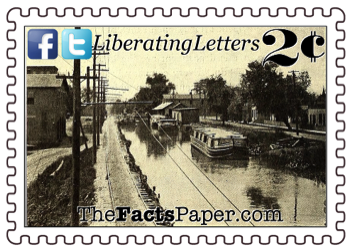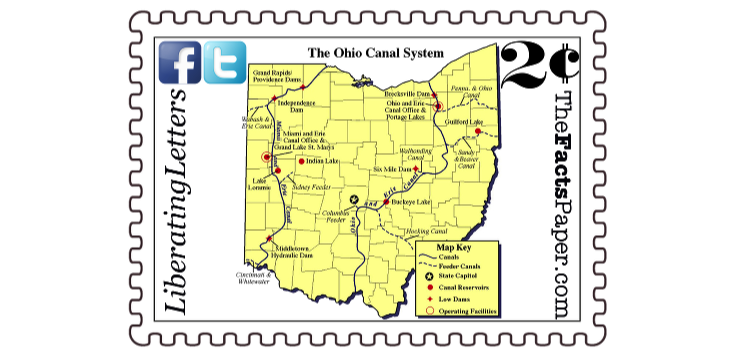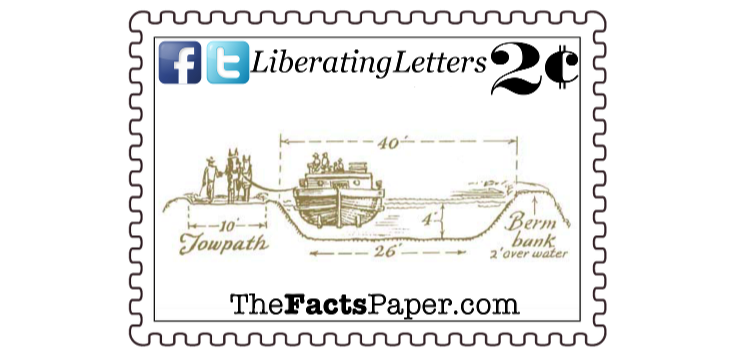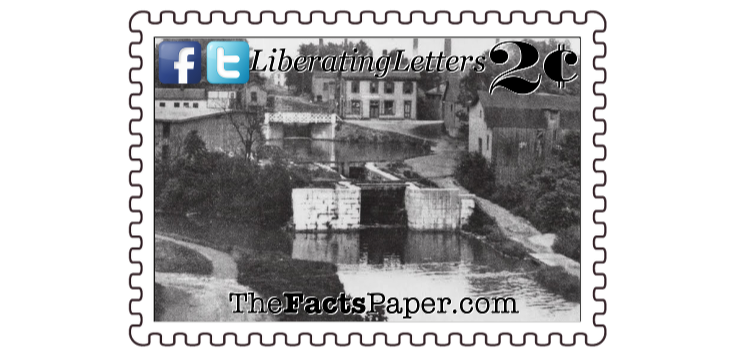The original plan called for all the lock boxes to be constructed out of stone. The swampy lands becoming home to the canal prevented wagons from delivering the necessary stone to numerous locks. Temporary ones made from nearby oaks were constructed with the idea they would be replaced with stone later. A plan that never happened. The entire Miami and Erie Canal was completed in 1844.
Along the canal, towns and communities developed about every 10 miles. Dayton started growing, becoming a major port, along with Hamilton, Middletown, Miamisburg, Troy, Piqua, and Celina. Just north of Cincinnati, at the location of the first set of locks heading out of the city, a town developed known as Lockland. Having to compensate for a 15-foot difference in the water tables, these locks generated massive water power. A water mill was quickly built which ground flour for the local farmers. Many other cities took advantage of the water power as well, adding to the economy and growth of western Ohio.
Ohioans were able to easily and cheaply send their grains, vegetables, and livestock of mainly pork, to markets. As more land cleared for farms and towns, loggers used the canals to send wood to other areas of the country. Travelers could also move about the state on smooth riding boats in comfortable chairs instead of bumpy, rough, coaches. One could journey from Dayton to Cincinnati in only 15 hours and from Toledo to Cincinnati in three days. When possible, travelers boarded the boats at night and woke at their destination in the morning.
By November, temperatures turned cold enough that the canal waters could freeze. Therefore they were drained into flat fields where ice ponds were formed. Once thoroughly frozen, the ice was cut and stored for use in the summer months. Boats were placed in dry docks where maintenance and repairs could be performed. The canals were refilled and active again once winter ended in March.
During the 1840’s and 50’s, the canal faced a threatening competitor. Railroads could lay track easier and quicker than digging canals, and travel by rail was incredibly faster. The Miami and Erie Canal hit its peak in tolls in 1851, but the state continued to support it for decades. Small towns not only still relied on the canals for transport, many mirrored Lockland by using the locks for significant water power. This purpose eventually resulted in the canal becoming more valuable for many cities than the travel, making the manmade waterways hard to abandon.
In addition to economic benefits, the canal contributed to a significant humanitarian cause. A free state, Ohio’s Miami and Erie Canal was used by the Underground Railroad as escaped slaves would follow the towpaths north. (see America's Moses) Towns along the way were not only canal stations, but safe havens for slaves on their way to freedom. During the Civil War, Ohio newspapers praised the canals for saving the Union as they freed up the railroads to carry out needed work for the war effort, such as moving war material.
Starting in 1863, wharfs and docks at terminals in larger cities, such as Cincinnati and Toledo, and Cleveland on the Ohio and Erie Canal, were filled in so rails could be constructed. By 1885, delivery companies primarily left the canal business but small operators developed a new market. They repurposed their boats as pleasure vessels, taking families on hunting and picnic trips. However, more and more sections fell into disrepair as the state and local cities stopped maintaining the waterway and locks, especially in northern portions of the canal.
The 1912-13 winter brought record snow and rainfalls to the state of Ohio. Known as the Palm Sunday Flood, waters from the reservoirs rushed the canals on March 23, 1913. Locks and aqueducts were heavily damaged or destroyed as water washed out the banks. Beyond repair, the state officially abandoned the canal, especially in the north, while Cincinnati and other southern towns continued to use the canal until 1929. With trains grabbing commercial transportation and cars replacing the rough and slow horse and buggies, the age of the canal had passed. (see Fording The Way) The country was moving forward and they were doing it with steam and gas engines. However, there is no doubt that Ohio was built in the canal.
Liberty, the Miami and Erie Canal holds a special place for me as Middletown is my hometown. I grew up traveling on roads either directly on or next to the old canal beds, and you are too. Every time I visited my grandmother in the nursing home, we traveled on a very wavy section of Route 4. My dad told me the road was placed on the old canal bed and it didn’t settle right, causing the waves. That history has always stuck with me.
When we pray, Liberty, we thank God for His blessings. Some of those blessings are a direct result of people 200 years ago deciding to journey into the wilderness and make something of it. They built canals, railroads, and roads so we could share our abundance of food with others and they could share their supplies with us. God is our steady and necessary lock that helps us adjust our path as we make our way down the canal. Putting our faith and trust in Him allows us to move forward when we come to an impasse as He takes on the burden of putting us where we need to be. Our spiritual lock, Christ rises us to a Heavenly level as He willingly lowered himself to ours and became sin for us.
Today, our public education system focuses entirely on tearing America down. To do that, they are demonizing or ignoring those who built it up. They send messages on their smart phone Social Media apps, blaming capitalism for all our troubles, before grabbing a coffee at Starbucks and jumping in their new Leaf to go shopping at their local organic grocery stores. They complain that white people took this land from the natives, while enjoying their community as it is today without a thought of the blood, sweat, and tears that occurred in between. When we lose our history, we deny those who paved our paths the respect they deserve. I refuse to do that, so my learning and teaching goes on.
That’s my 2 cents.
Love,
Mom
July 21, 2019
Dear Liberty,
Today’s highways are filled with people traveling 70 miles an hour to destinations hundreds of miles away. Trucks transport goods throughout states, opening commerce and building economies. Information travels at the speed of an electronic emoji. For us, easy and fast is a way of life and taken for granted. Two hundred years ago, speed was an inconceivable luxury.
The British acquired the Northwest Territory in the French and Indian War, encouraging natives to attack the colonists as the drumbeats of Revolution got closer. (see Join, Or Die and The Forgotten Battle) Settlers were already in Kentucky thanks to Daniel Boone, and were ready to push into lands of Ohio after winning it during the War of Independence. (see The Founding Father Of Westward Extension and How The North Was Won) Again encouraged by the British, the Indian Wars led by Shawnee leader Blue Jacket prevented safe settlements until the Battle of Fallen Timbers on August 20, 1794. Soon after, many Americans, including historical icons Johnny “Appleseed” Chapman and Simon Kenton, set their sights on the beautiful Ohio Country, governed by Arthur St. Clair. (see Finding Johnny Appleseed’s Core, The Frontiersman, and Charting A New Course)
Settlers in Ohio adopted a state Constitution on February 19, 1803, officially becoming a state on March 1, 1803. Immediately, the state’s new Congress, led by Governor Edward Tiffin, began researching modes of transportation to reach settlers and ship the state’s goods to other areas. Wagons and stagecoaches carrying goods and people were expensive while flatboats on rivers were often damaged, losing their cargo. On March 26, 1806, President Thomas Jefferson signed legislation to begin construction of the National Road (Rt. 40) from Massachusetts to the West, but keeping the dirt road passable was often difficult. At the same time, New York began building the Erie Canal in 1817, greatly improving the state's economy and market by providing a superior means of transporting goods.
While cities on waterways, such as Cleveland, Toledo, and Cincinnati, were growing due to their convenient travel sources, central Ohio was struggling. The rich Ohio agricultural land yielded more produce and livestock than the state could consume, products that were highly desirable along the Atlantic coast. And some isolated portions of the state remained unsettled because there were simply no easy access points to attract new citizens. Even the small town of Dayton located on the Great Miami River could not utilize the mighty river as it only flowed one direction and was not suited as a consistent traveling source. Therefore, seeing the success of New York's Erie Canal, Governor Jeremiah Morrow decided Ohio needed to construct its own waterway. Prominent leaders met in Lebanon, Ohio, at The Golden Lamb to discuss plans. After passing the proper legislation, conducting the necessary surveys, and obtaining the required land, construction began on two separate canals in Ohio. They were called the Ohio and Erie Canal and Miami and Erie Canal.
The Ohio and Erie Canal extended from Cleveland in northeast Ohio through central Ohio to Portsmouth on the Ohio River. Governor Morrow invited New York’s Governor De Witt Clinton to help him break ground for this waterway on July 4, 1825. The men traveled to southwest Ohio where The Golden Lamb hosted a dinner for Clinton, which was attended by Morrow, previous Ohio Governor Ethan Allen Brown, future president General William Henry Harrison, and Secretary of State Henry Clay. It proved to be the largest gathering of prominent attendees at the now historical inn.
LOCKING IN OUR FUTURE


Following a large ceremony on July 21, 1825, they gathered on Daniel Doty’s farm in Middletown, Ohio, considered the town’s first settler, and broke ground for the Miami and Erie Canal. The waterway would connect Toledo to Cincinnati in western Ohio. Located between Dayton and Cincinnati, construction began out of Middletown in both directions. Engineer Samuel Forrer oversaw the southern portion of the canal, which was completed in 1827, with a boat named after him being the first to leave Middletown. On November 28, 1827, the first boats arrived in Middletown from Cincinnati. Two months later, the section from Middletown to Dayton opened on January 22, 1829.
Starting in Toledo, water from the Maumee River helped supply the Miami and Erie canal, but other water supplies were needed in the northern area. Three major reservoirs were built including Grand Lake near St. Mary’s and Lake Loramie a little further south. Due east, at the mouth of the Great Miami River, Indian Lake was constructed to supply that river and a tributary of the canal. The main canal and this section, known as the Sidney Feeder Canal, met up at Piqua, where it continued south along the Great Miami until Hamilton. At that point, the canal broke away to head towards Cincinnati where it met up with Mill Creek before traveling to the Ohio River.

Plans required a four-foot deep ditch, 26 feet wide at the bottom and 40 feet wide at the top. In addition, a 10-foot towpath accompanied the canal on the West side. Teams of two mules walking along the towpath pulled the boats of cargo and passengers along the waterways at a top speed of 4-miles an hour. The speed limit was invoked to avoid wakes washing away the banks, damaging other boats, and preventing the mules from tiring out too quickly.
Having no modern day tools, the entire 224 miles of the “Big Ditch” was manually cleared of trees and rocks, dug out and hulled away by hand, strong shoulders and horses. As a free state, all the workers were free men looking to build a better life for themselves as they built a better future for their communities. In places of severe elevation change, land was built up or dug deeper in several locations while turns and curves compensated in other areas. However, 105 locks were constructed on an average of every 4 miles along the entire canal. These locks, or gates, enclosed areas where boats entered and were shut in. Water was then added or drained to raise or lower the boat to the level of the next section of the canal, a process that took approximately 15 minutes. These water elevators were key to navigating the canal through the changing altitudes of Ohio.



